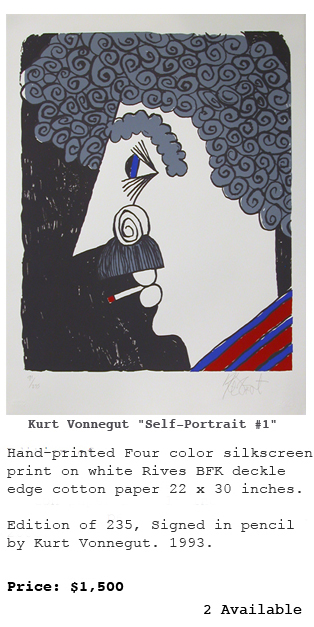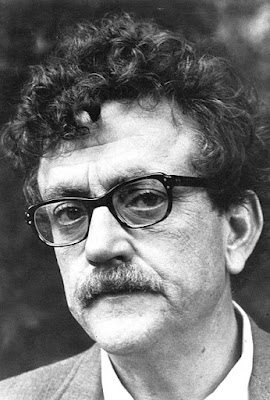 |
| Contact: info(at)vonnegutdoc.com |
In the original conception of the article my intent was to write about the screen printed artwork of Jonathan Winters. I interviewed Winters for near forty-five minutes (a rare and highly entertaining privilege, which I hoped one day to turn into a couple articles for this Northland rag) and spent a great deal of energy shaping what amounted to be a very weak piece about screen printing, because Mr. Winters did not do much screen printing. Joe Petro did the screen printing for him.
The rejection letter was very kind, leaving the door open for another pitch. I replied that Joe Petro himself would make a great story, since he was doing work for all these high profile people. With a little luck I might get access to some of these. Sure enough, the finished piece appeared in January 2004 under the title, “Serigraphy, Celebrities & Joe Petro.” It was a lot of fun.
One of the celebrities in my article happened to be the author Kurt Vonnegut, whose creative output was not limited to the written word. He was also an artist. I called him at his
I originally wrote the following for my website shortly after Mr. Vonnegut passed on April 11, 2007. He was 84.
•
As the Boomer generation came of age, Kurt Vonnegut became one of its most important voices. When I was in college at O.U. (
What attracted many readers to Kurt Vonnegut were his pointed social insights packaged in absurd, surreal stories. There is no mistaking Slaughterhouse Five for something that really happened. It is fiction. But in fiction anything can happen, and in this book it does. The story line, however, is not what the book is about. Yes, Billy Pilgrim is abducted by aliens; yes, he moves back and forth through time; yes, the story is whimsical yet dead serious.
Slaughterhouse Five is about the meaning of life, or the search for meaning after seeing the absurdly horrorific consequences of war. The real story Vonnegut tells is the firebombing of
I find it interesting that the Serenity Prayer – help me accept the things that I cannot change and have the wisdom to know the things I can change – appears twice in this book, because the story line of Vonnegut’s God Bless You, Mr. Rosewater so parallels Franco Zefferelli’s Brother Sun, Sister Moon about the life of St. Francis. The hero, Elliot Rosewater, is a highly decorated war veteran who accidentally bayoneted a 14 year old civilian. He mentally comes unglued. Or does he? To his rich and powerful family, he behaves like a kook because instead of carrying on the traditions of wealth and power and privilege, he actually chooses to help people. Like I say, it seems like a modern re-telling of the life of St. Francis.
Like Ernest Hemingway, Vonnegut was a journalist before becoming a novelist. Like Mark Twain, he wrote somewhat comic stories with incisive venom. Like Kafka’s Metamorphosis, about a boy who wakes up a cockroach, Vonnegut’s tales yield their best fruit when you buy in to the absurd framework of the story.
•
 |
| A few blocks from the Vonnegut museum in Indy. |
For my interview I prepared a series of questions. He was expecting my call. When I spoke with him that October afternoon I began by mentioning that he and Herman Hesse had been the two most influential writers for me when I was in school, a light bit of flattery, adding that I had read nearly everything he wrote. His response caught me completely off guard.
“You must be lonely,” he replied. He wasn’t too flattered by the flattery.
“Why is that?”
“Because all of
It knocked me completely off the rails. I wanted to ask my next question, but had an inward whirlwind taking place. Part of me wanted to defend myself. “That was 30 years ago!” Another part of me attempted to assess how much truth was in his words (more than I wanted to admit, actually), and a third part of me had to get back on track, re-connect with the man on the other end of this telephone line.
Fortunately he was amenable and began telling me about his friendship with Joe Petro, how he and Joe took some of his art and turned it into prints. It must have gone well because, “Joe said, ‘Why don’t we keep going’ and so we did.”
Vonnegut shared a little of how he came to make art. “I’ve been a painter, a farter around. My father was a painter. So was my grandfather. They were both architects, but also painted. So Joe and I kept going, and here we are.”
Of the screen printing process, he added, “What a crazy way to make a picture in the age of the computer. In a way it’s very physical. It’s dance. He moves around and there’s all kinds of stuff for his hands to do… a lot of movement.” One could tell by the intonations that he was impressed with the Petro's artistry.
I asked how they work together. “My job is to be satisfied with his reproductions,” Vonnegut said. “What he does is to reproduce exactly what I have done. Sometimes he will suggest a different color background, choose the paper.”
_-_Vonnegut.jpg) |
| First Vonnegut book I read. |
Hearing that I was from Northern Minnesota, he noted, “The most provincial people in the world are
Of the article I was working on he said, “Joe Petro is a worthy story.”
Regarding his initial meeting with Petro half a lifetime ago he said, “A funny thing happened on the way to the lecture.”
Near the end of my brief time with him he asked for a little more about myself and my
After a short time together, it became apparent that he was being courteous to me for the sake of a friendship with his printmaker.
As I write these lines, I am aware that Joe himself is probably at near Kurt’s side in
~ April 15, 2007
# # # #
Related Links
Visit www.vonnegut.com for a Joe Petro tribute to this significant German American writer.











No comments:
Post a Comment